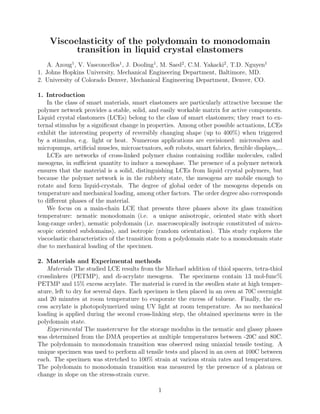Viscoelasticity of Polyodmain to Monodomain transition in liquid crystal elastomers
This study explores the viscoelastic properties of the transition from a polydomain to a monodomain state in liquid crystal elastomers (LCEs) due to mechanical loading. LCEs are polymer networks containing mobile rod-like mesogens that can transition between ordered and disordered phases in response to temperature and stress. The researchers characterized the storage modulus of an acrylate-based LCE using dynamic mechanical analysis over a range of temperatures and applied time-temperature superposition to develop a mastercurve. Uniaxial tensile tests on the polydomain LCE specimen at varying strain rates and temperatures showed a plateau or slope change indicating the polydomain to monodomain transition. Preliminary results found that time-temperature


Recommended




















































More Related Content
Similar to Viscoelasticity of Polyodmain to Monodomain transition in liquid crystal elastomers (20)










































Viscoelasticity of Polyodmain to Monodomain transition in liquid crystal elastomers
- 1. Viscoelasticity of the polydomain to monodomain transition in liquid crystal elastomers A. Azoug1 , V. Vasconcellos1 , J. Dooling1 , M. Saed2 , C.M. Yakacki2 , T.D. Nguyen1 1. Johns Hopkins University, Mechanical Engineering Department, Baltimore, MD. 2. University of Colorado Denver, Mechanical Engineering Department, Denver, CO. 1. Introduction In the class of smart materials, smart elastomers are particularly attractive because the polymer network provides a stable, solid, and easily workable matrix for active components. Liquid crystal elastomers (LCEs) belong to the class of smart elastomers; they react to ex- ternal stimulus by a signi’¼ücant change in properties. Among other possible actuations, LCEs exhibit the interesting property of reversibly changing shape (up to 400%) when triggered by a stimulus, e.g. light or heat. Numerous applications are envisioned: microvalves and micropumps, arti’¼ücial muscles, microactuators, soft robots, smart fabrics, ’¼éexible displays,... LCEs are networks of cross-linked polymer chains containing rodlike molecules, called mesogens, in su’¼ācient quantity to induce a mesophase. The presence of a polymer network ensures that the material is a solid, distinguishing LCEs from liquid crystal polymers, but because the polymer network is in the rubbery state, the mesogens are mobile enough to rotate and form liquid-crystals. The degree of global order of the mesogens depends on temperature and mechanical loading, among other factors. The order degree also corresponds to di’¼Ćerent phases of the material. We focus on a main-chain LCE that presents three phases above its glass transition temperature: nematic monodomain (i.e. a unique anisotropic, oriented state with short long-range order), nematic polydomain (i.e. macroscopically isotropic constituted of micro- scopic oriented subdomains), and isotropic (random orientation). This study explores the viscoelastic characteristics of the transition from a polydomain state to a monodomain state due to mechanical loading of the specimen. 2. Materials and Experimental methods Materials The studied LCE results from the Michael addition of thiol spacers, tetra-thiol crosslinkers (PETMP), and di-acrylate mesogens. The specimens contain 13 mol-func% PETMP and 15% excess acrylate. The material is cured in the swollen state at high temper- ature, left to dry for several days. Each specimen is then placed in an oven at 70C overnight and 20 minutes at room temperature to evaporate the excess of toluene. Finally, the ex- cess acrylate is photopolymerized using UV light at room temperature. As no mechanical loading is applied during the second cross-linking step, the obtained specimens were in the polydomain state. Experimental The mastercurve for the storage modulus in the nematic and glassy phases was determined from the DMA properties at multiple temperatures between -20C and 80C. The polydomain to monodomain transition was observed using uniaxial tensile testing. A unique specimen was used to perform all tensile tests and placed in an oven at 100C between each. The specimen was stretched to 100% strain at various strain rates and temperatures. The polydomain to monodomain transition was measured by the presence of a plateau or change in slope on the stress-strain curve. 1
- 2. 3. Preliminary results We show that (i) the time-temperature superposition (TTS) factors determined from small strain measurements apply in the large strain regime, and (ii) the TTS theory applies to the strain range and stress level of the transition using the same shift factors. Finally, we explore the change in e’¼Ćective viscoelastic properties due to the orientation of the mesogens from a polydomain to a monodomain state. These results allow us to envision a modeling strategy based on modi’¼üed linear viscoelasticity theories. 2
